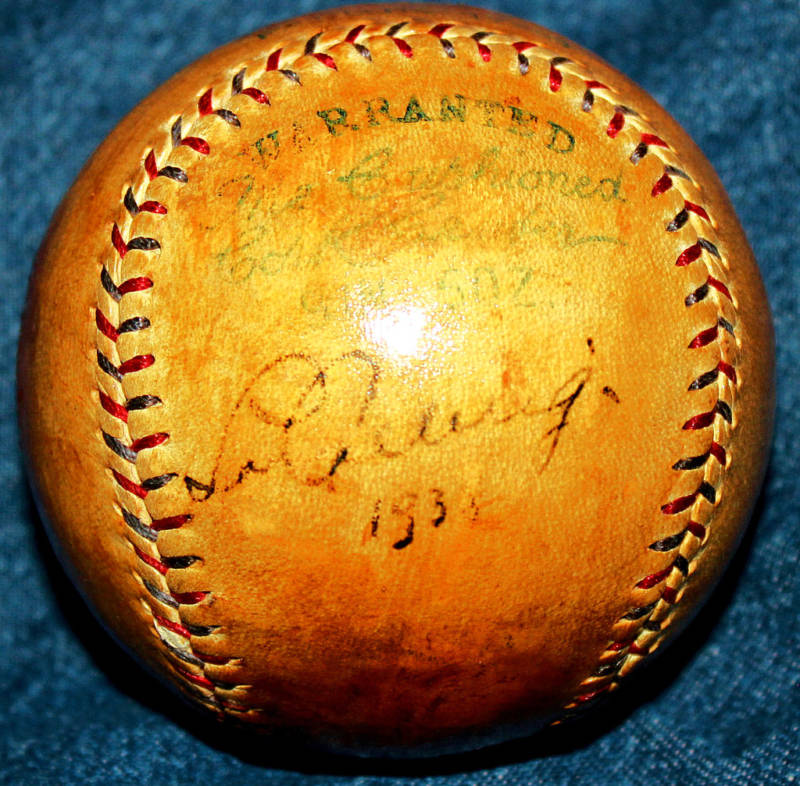What happens when two balls are in play at once?
比賽進行中 同時兩顆球進入攻守運作會怎樣?
Chaos, that's what happens
結果就是:亂!
We all know how a game of baseball works: A pitcher throws a ball to a batter who tries to hit it.
我們都知道棒球比賽運作的原理:投手對打者丟出球,打者試著擊中球。
If he puts it in play, the fielders then try to catch it, and maybe they'll toss it around to a couple of their teammates.
如果打者將球打進場中,野手嘗試攔截球,接著可能在幾個隊友之間轉傳球。
After they've done that a sufficient amount, the ball goes back to the pitcher, a new hitter steps up and the whole thing repeats.
他們完成一定的程序後,球回傳給投手,新的打者再上場,重複整個流程。
You'll notice that at every point in that process, there's only one baseball in use at a time.
你會注意到無論哪個攻守環節,都只有一顆棒球參與其中。
It's sort of central to the whole thing.
這可以說是整個運作過程的基礎核心。
But one time, during a game on Tuesday, June 30, 1959, between the Cubs and Cardinals at Wrigley Field, the old order broke down and chaos reigned:
但有一次,一場1959年6月30日、周二的比賽,由小熊隊在主場瑞格里球場(Wrigley Field)出戰紅雀。上述的基本原則被打破了,場上一片混亂:
Two balls found their way into play at the same time.
竟然有兩顆球在場上同時進入攻守運作。
One can only imagine the lack of import surrounding this Tuesday afternoon game.
你可以想像週二下午那場比賽的攻擊火力輸出有多弱。
The Cubs hadn't had a winning season in over a decade, even with Ernie Banks in the middle of his prime.
因為小熊已經超過10年沒有勝率超過5成的球季(註1),即便Ernie Banks(註2)當時正處於生涯巔峰也無濟於事。
The Cardinals had Stan Musial, but still hadn't been to the postseason since 1946.
紅雀即便有Stan Musial(註3),但自從1946年以來就沒有進過季後賽(註4)。
Both teams entered with losing records and -- spoiler alert -- both would end the season in the bottom half of the National League standing.
兩支球隊交手前勝率都不滿5成,還有——劇透請小心——兩支球隊在下半季的排名都只能直接打包回家(無法進季後賽)。
So, it was likely a surprise when, in the middle of the fourth inning, history broke out.
所以,比賽在第四局發生的事情令人感到驚奇,也創造了歷史。
The Cardinals led, 2-1, with one out and no one on in the top of the fourth inning.
當時四局上半一出局,無人在壘,紅雀隊進攻,以2比1領先。
Musial was at the plate and had worked the count to 3-1 on Cubs starter Bob Anderson.
輪到Musial打擊,對陣小熊隊先發Bob Anderson,球數1好3壞。
According to the box score, here's what happened next: Musial drew a walk, then got tagged out between second and third after trying to advance on a wild throw.
根據當時的比賽紀錄,接下來的攻守紀錄是:Musial選到四壞球保送,但想趁暴傳上三壘,在二壘跟三壘之間被觸殺出局。
But that's only half the story, at most.
但這只說了故事的一半。
Ball four to Musial had sailed to the backstop, narrowly missing Musial's bat on the way by.
第四顆壞球飛到了本壘後方,過程跟Musial的棒子只有一點點的距離。
The Cubs all thought it was a foul ball, but umpire Vic Delmore never ruled the ball dead or called time.
小熊隊認為那是一顆界外球,但主審Vic Delmore從頭到尾沒有判決那球是死球狀態或時間暫停。
Cubs catcher Sammy Taylor began arguing with the umpire while Musial headed toward first base.
小熊隊的捕手Sammy Taylor開始跟主審理論,同時Musial已經走向一壘。
Anderson came in from the mound to join the debate.
投手Anderson也走下投手丘加入(捕手與主審的)爭論。
Sometime early in the argument, Delmore inadvertently gave Taylor a new baseball.
就在爭論一開始的時候,主審Delmore就已遞給捕手Taylor一顆新球。
The problem with that, of course, is that the ball boy had already retrieved the original ball -- the one that still wasn't ruled out of play -- and rolled it toward Pat Pieper, the public address announcer.
問題在於,可想而知,球僮已經把爭議判決的原用球收起來,並把球滾向了球場的廣播員Pat Pieper,但這顆球還未被判決已不在比賽的運作中。
Cubs third baseman Al Dark, not sure what the ruling on the field was, ran to the backstop to retrieve the original (still live) ball.
結果小熊隊的三壘手Al Dark(註4),因為並不確定場上的最終判決是什麼,跑向了本壘後方撿起這顆爭議球(譯者註:因主審沒判,理論上還是一顆活球)。
Musial, meanwhile, decided to try to steal second during the commotion.
同一時間,(因保送上一壘)的Musial決定趁亂盜二壘。
Anderson saw what Musial was trying to do and grabbed the new ball from his catcher's glove.
捕手Anderson看到Musial的動作,馬上從手套拿出新球。
Dark caught on at around the same time, which meant that two different baseballs wound up sailing toward second base in an attempt to catch Musial.
三壘手Dark也差不多在同一時間抓起球,也就代表為了抓Musial出局,兩顆不同的球最終都會傳向二壘。
Anderson's throw sailed over the second baseman's head and into the outfield.
結果Anderson的傳球飛過了二壘手的頭頂,落在外野。
Dark's throw was better -- a one-hopper to Banks.
Dark的傳球準一些,一個彈跳傳給了游擊手(Ernie)Banks。
Unaccustomed to the dynamics of two balls in play at once,
兩顆球同時在場上飛竄,已經很不尋常,
Musial saw Anderson's throw rolling toward center field and reacted, immediately popping up and heading toward third base ...
Musial看到Anderson滾向中外野的暴傳,馬上彈起來再衝向三壘...
at which point Banks, still holding the original ball, tagged him out.
同一時間拿著爭議球的Banks,就把Musial觸殺出局了。
Musial was justifiably confused.
Musial情有可原地感到困惑。
“To me, the funniest thing was watching Musial ... wandering around there and [asking], 'What the hell is going on here?'” Anderson said.
「對我來說,最好玩的就是看著Musial在那裡進退維谷,然後問:『這到底是怎麼一回事?』」捕手Anderson說道。
Of course, Cardinals manager Solly Hemus wasn't laughing.
可想而知,紅雀的總教練Solly Hemu完全笑不出來。
Both he and Cubs manager Bob Scheffing spent 20 minutes arguing with the umpiring crew.
他跟小熊隊的總教練Bob Scheffing花了20多分鐘跟裁判群爭執。
By the time the dust settled, Musial was still out, and the Cardinals played the rest of the game under protest. (St. Louis ultimately overcame the controversy to win, 4-1, rendering their protest irrelevant.)
爭議終於漸漸平息,Musial還是被判出局,紅雀則在剩下的比賽中持續抗議。(紅雀隊最終以4比1克服爭議,贏得比賽,也讓他們的抗議反倒無關緊要)
But while two balls in play was chaotic enough, what if there were actually three balls involved in the play? Yes, there exists a third-ball theory.
不過,你以為兩顆球同時在場上運作就夠複雜了,如果同時有三顆球呢?對的,第三顆球的理論是存在的。
Where the original story has Dark intercepting the ball before it reached Pieper, the public address announcer, Anderson has a different version of events.
原來的故事版本是,三壘手Dark在球滾到球場廣播員Pieper之前,就把球撿起來,捕手Anderson則提供了不同的視角。
He claims the ball reached Pieper, who immediately deposited it in a large bag filled with baseballs.
他聲稱,球已經滾到了Pieper,Pieper並將球收進了裝滿球的大袋子中。
Instead of retrieving the ball directly, Dark approached the announcer.
三壘手Dark因為沒能把球拿回來,走向廣播員。
"Al came over and said, ‘Don’t say anything, Pat … Give me a ball,’" Anderson said. "It may not have been the same ball.”
「Al(三壘手)走向廣播員說:『什麼話都不要說,給我一顆球』」,捕手Anderson說:「其實可能已經不是同一顆球了。」
Unfortunately, there is no way to know for sure whether the Two Balls in Play Incident was actually the Three Balls in Play Incident.
不巧的是,無從確認到底「兩顆球事件」,是否其實是「三顆球事件」。
While video once existed of the game from a Cubs highlights package, it was apparently taped over so the network could record another program.
那場比賽的錄像一度存在小熊隊比賽精華的集錦中,但小熊電視台要錄製另一檔節目,以致(那場的比賽片段)被覆寫了。
Regardless of the precise number of balls involved, it's a situation we're unlikely to ever see again,
無論確切有幾顆球涉入當時的狀況,我們不可能再看到這種狀況。
especially with the advent of replay review and multiple camera angles on every play.
尤其是重播、重看技術的進步,以及針對每個攻守動作都設有多角度攝影。
Inadvertently anticipating advances in technology with typical pre-2016 Cubs fatalism,
小熊隊不經意參與推動了科技的進步,很符合2016年之前小熊宿命論的典型表現。(註5)
Anderson was more right than he knew when he observed, "Only with the Cubs at that time could something like that happen."
捕手Anderson的觀察比他想像中的還要中肯許多:「也只有那個時候的小熊隊會發生這樣的事情啦。」
註1:小熊隊從1947年開始,直到1958年單季勝率都沒有超過5成,直到1963年才再度突破5成。(https://reurl.cc/arD4bl)
註2:Ernie Banks,1953年到1971年生涯都在小熊隊,共效力19個球季,通算擊出2583支安打,512轟,1636分打點,兩度奪得MVP,於1977年獲選為名人堂成員。
註3:Stan Musial,1941年到1963年22球季都在紅雀隊效力,生涯3630支安打,475支全壘打,1951分打點,生涯打擊三圍.331、.417、.559,3度獲選MVP,1969年入選名人堂。
註4:紅雀隊1947年到1963年都未打入季後賽,直到1964年贏得世界大賽冠軍。
註5:小熊隊直到2016年奪下世界大賽冠軍,才終結長達71年的「山羊魔咒」,與108年未奪世界大賽的記錄。
7wZ86hKBMhUEH557!~~_3.jpg)
沒有留言:
張貼留言